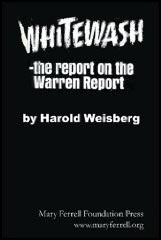This blog discusses the assassination of President John F. Kennedy on November 22, 1963. I apply 50 years of interest and research, which include both lone assassin and conspiracy viewpoints, into this blog. I invite readers to share their comments and respond to differing points of view.
Monday, April 30, 2012
WHITEWASH: AT THE DEPOSITORY-THE TANGIBLE EVIDENCE V
April 30, 2012
WHITEWASH-the report on the Warren Report by Harold Weisberg, Chapter 5: At The Depository - The Tangible Evidence V
Knoxville, Tennessee (JFKASSASSINATION) Today this blog continues our report on Chapter 5 of Harold Weisberg's book "Whitewash--the report on the Warren Report", published in 1965.
The title of Chapter 5 is At The Depository -- The Tangible Evidence
Harold Weisberg points out that the Warren Commission's so-called star witness, Howard Leslie Brennan, who had been sitting on a concrete wall directly across from the Texas School Book Depository at the time of the shooting, went to his home after giving a statement to police, saw pictures of Oswald on TV, returned to the police station for a line-up & then....
"failed to identify Oswald."
Mr. Weisberg goes on to say that when Brennan was asked by the Commission if he saw the rifle "discharge....recoil...or the flash?," he answered no.
Harold Weisberg also tells us that despite the abundance of photographs taken at the scene, the Commission was very selective in the ones they chose to publish in their report.
He also finds fault with the Commission's reenactment of the assassination which was inexplicably delayed until 6 months later.
Mr. Weisberg gets right to the point concerning Abraham Zapruder's 8mm home movie of the assassination:
"This film may have been the best single piece of evidence of the crime. But the Commission, while having access to it from the beginning, never called (Abraham) Zapruder as a witness until toward the end of the hearings."
Weisberg explains that not only was Zapruder the man who made the film, he was perhaps the best eyewitness because looking through his camera's zoom lens, he had a better view than other witnesses.
Subscribe to:
Post Comments (Atom)

Will this help you?
ReplyDeletehttp://giljesus.com/jfk/brennan.htm
At the lineup, Brennan selected Oswald as the person who most closely resembled the man he had seen in the window with the rifle, but he failed to make a positive identification.
After an "agent" spoke with him a few weeks later, Brennan seemed to revert to being unable to positively identify Oswald.
The relationship of the windowsill to the floor made it impossible for the shooter to be standing while firing, as Brennan claimed. If the shooter was sitting or kneeling, it would have been impossible for Brennan to estimate his height and weight..
Brennan's description of the clothing worn by the man in the window was inconsistent with the outfit Oswald was wearing that day.
His failure to make a positive identification of Oswald, as well as the issue of the gunman's clothing, make it impossible to fairly cite Brennan as proof that Lee Harvey Oswald was on the sixth floor, a fact
which even the Warren Commission recognized.
The Warren Commission dealt with the dilemma of Brennan's uncertainty in this manner:
"The Commission ... does not base its conclusions concerning the identity of the assassin on Brennan's subsequent
certain identification of Lee Harvey Oswald as the man he saw fire the rifle...
According to Secret Service agent Forrest Sorrels, Brennan knew that he was not the only eyewitness. When Sorrels spoke with Brennan at the TSBD about half an hour after the assassination, Brennan himself pointed out young Amos Euins as one who had seen the gunman.
The most reasonable explanation for Brennan's failure to ever make a positive identification of the man is that he never saw him again--at the lineup or elsewhere. Brennan's eyesight was so bad at the time he viewed the lineup, he told the Commission the lineup consisted of "seven, more or less one". There were never more than 4 in any lineup.
It was not Brennan but a "Secret Service man from Houston" who first suggested "security reasons" as an excuse to the reluctant witness: "You said you couldn't make a positive identification. Did you do that for security reasons personally or couldn't you?" is how Brennan quoted the agent.
In August, 1964, before the release of the Warren Report, Brennan spoke on camera with CBS News, for their nationwide broadcast, "CBS News Extra: November 22, 1963 and the Warren Report," aired on
September 27, 1964. Interviews were done, according to narrator Walter Cronkite, a month before the telecast and the release of the Warren Report.
Brennan also posed for a photograph which appeared in the October 2, 1964 issue of Life magazine. If Brennan was taking steps to avoid public exposure, they were certainly extraordinary steps. ( In the CBS program, Brennan blatantly contradicted his sworn Warren Commission testimony when he told the nation that "The President's head just exploded." )
Brennan's eyesight was so poor that he could not determine how many people were in the lineup.
Brennan's eyesight was so poor that he "couldn't remember" if all of the men in the lineup were white.
Brennan's eyesight was so poor that he saw Capt. Fritz at the lineup when Fritz wasn't there.
No Dallas Police officer ever made a reference in testimony to a lineup viewed by Brennan.
Brennan's name does not appear on any witness list as having viewed one of the Oswald lineups.